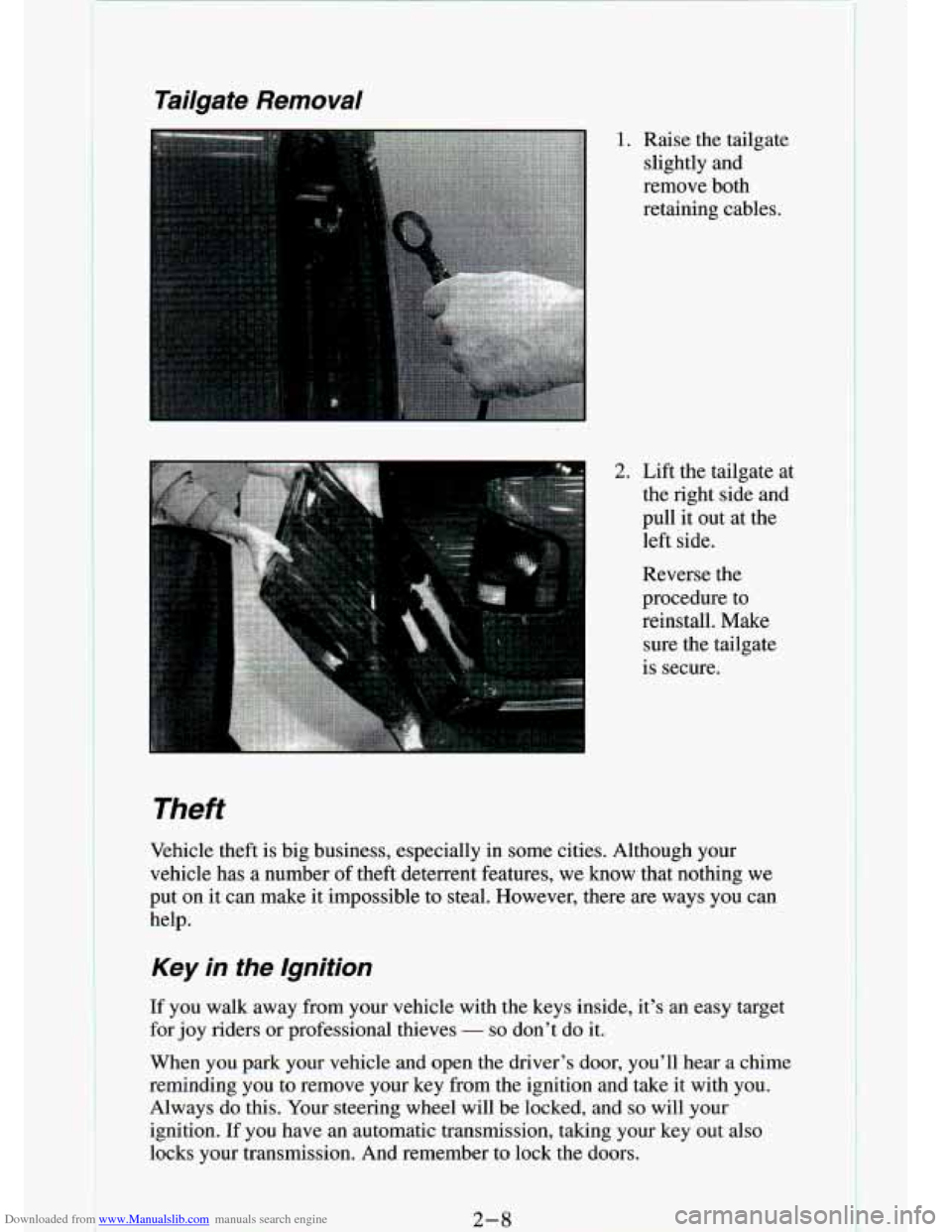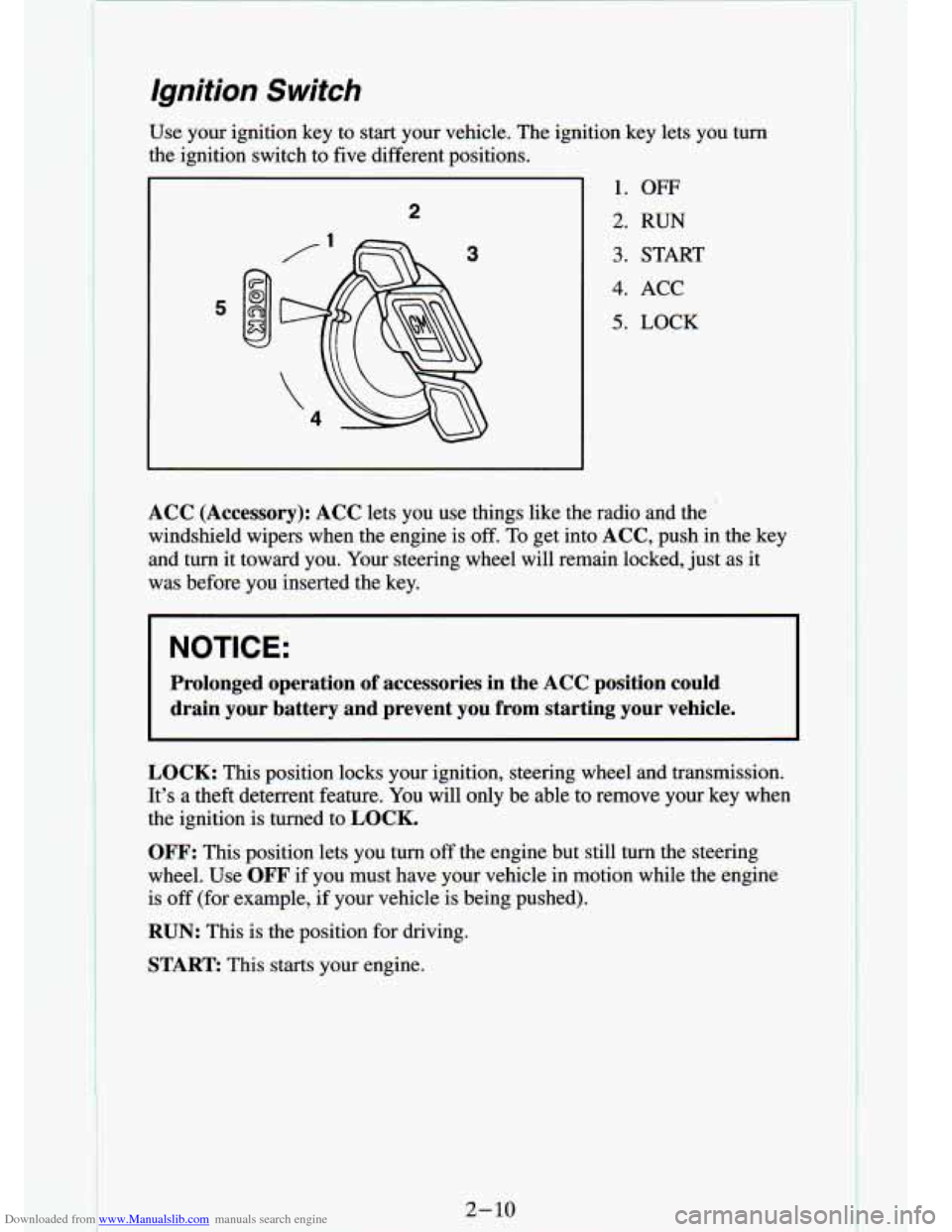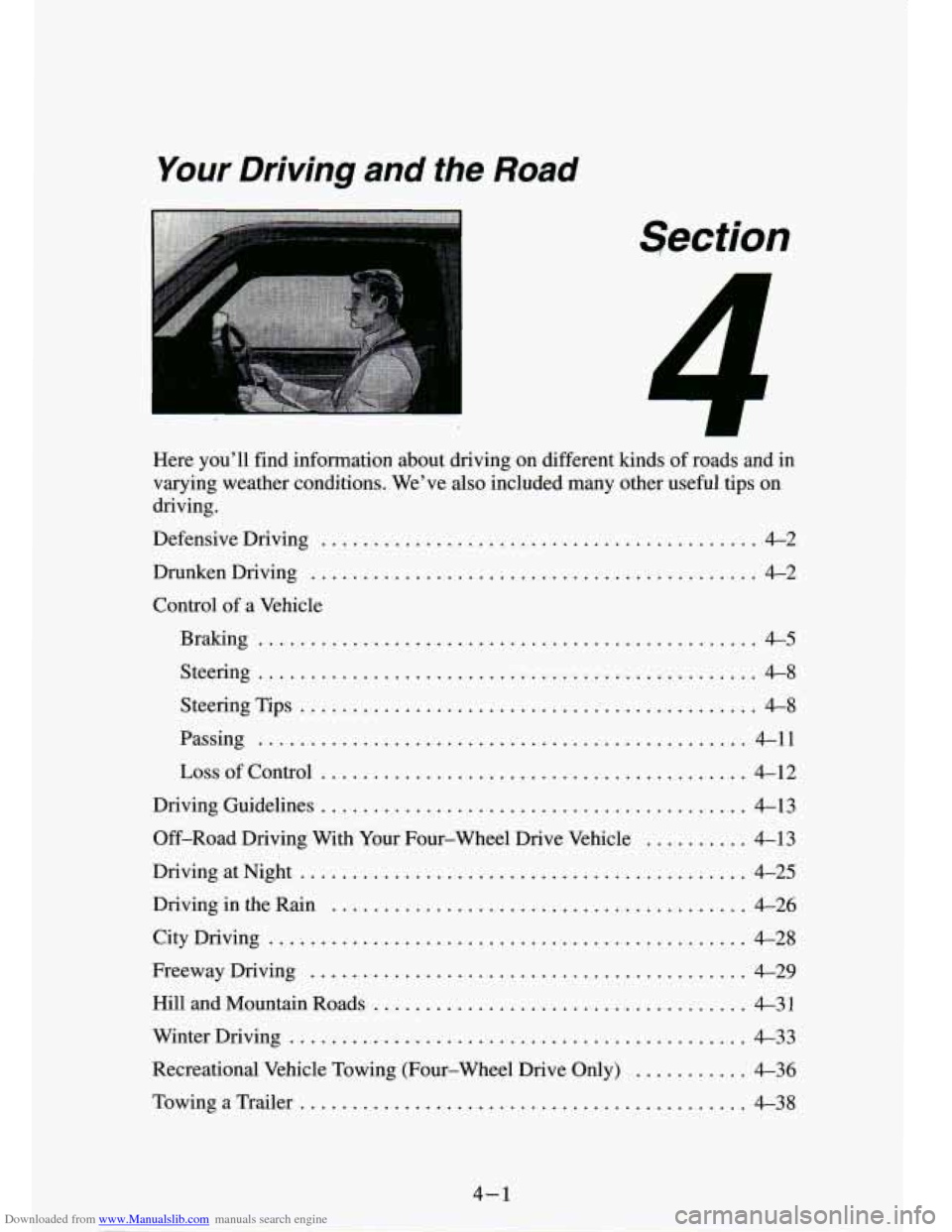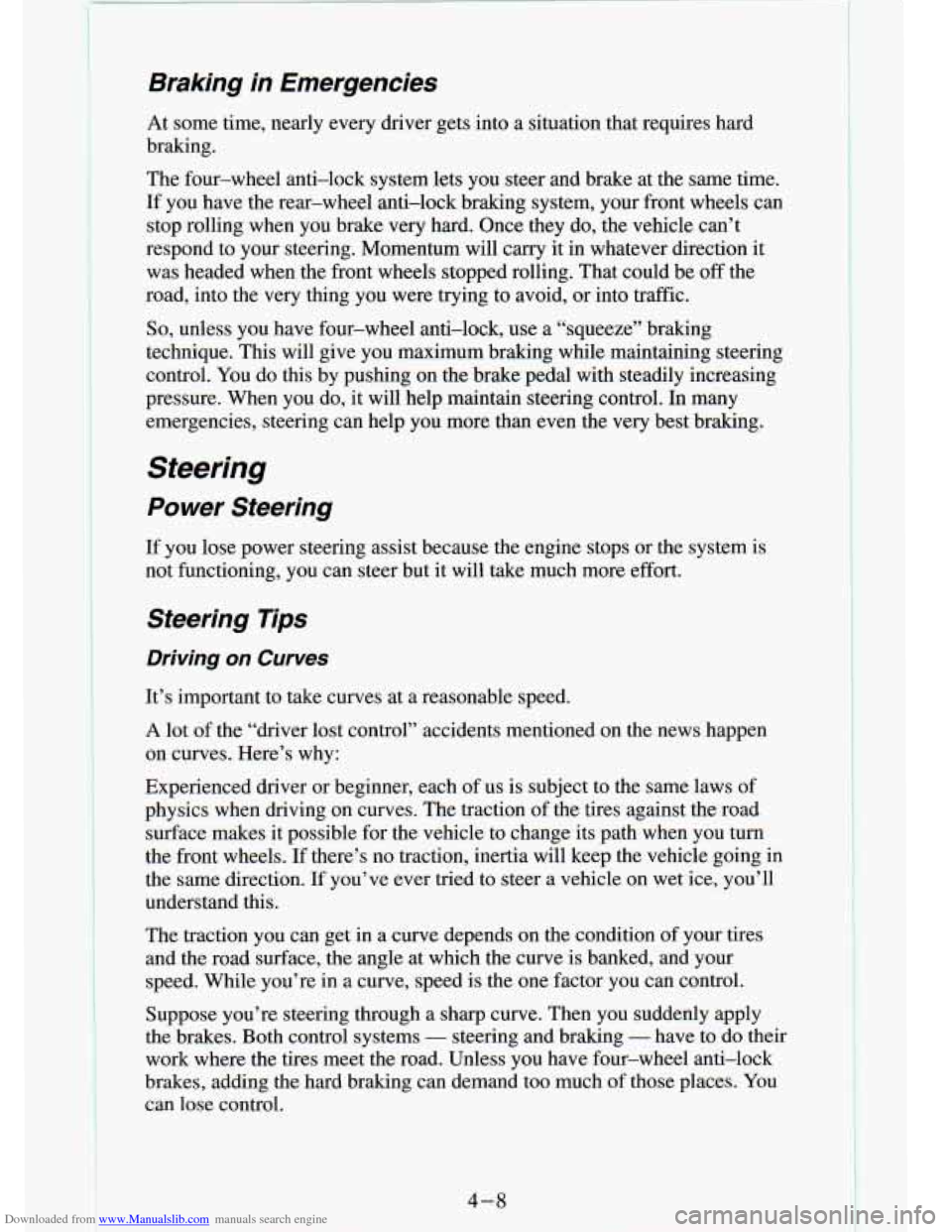Page 54 of 340

Downloaded from www.Manualslib.com manuals search engine Tailgate Removal
Theft
1.
2.
Raise the tailgate slightly and
remove both
retaining cables.
Lift the tailgate at the right side and
pull
it out at the
left side.
Reverse the
procedure to
reinstall. Make sure the tailgate
is secure.
Vehicle theft is big business, especially in some cities. Altho\
ugh your vehicle has
a number of theft deterrent features, we know that nothing we
put on it can make it impossible to steal. However, there are ways you can
help.
Key in the Ignition
If you walk away from your vehicle with the keys inside, it’s an easy target
for joy riders or professional thieves
- so don’t do it.
When you park your vehicle and open the driver’s door, you’\
ll hear a chime
reminding you to remove your key from the ignition and take i\
t with you.
Always do this. Your steering wheel will be locked, and
so will your
ignition.
If you have an automatic transmission, taking your key out also
locks your transmission. And remember to lock the doors.
2-8
Page 56 of 340

Downloaded from www.Manualslib.com manuals search engine Ignition Switch
Use your ignition key to start your vehicle. The ignition key \
lets you turn
the ignition switch to five different positions.
2
3
1. OFF
2. RUN
3. START
4. ACC
5. LOCK
ACC (Accessory): ACC lets you use things like the radio and the
windshield wipers when the engine is
off. To get into ACC, push in the key
and turn it toward you. Your steering wheel will remain locked, just as it
was before you inserted the key.
NOTICE:
Prolonged operation of accessories in the ACC position could
drain vour battery and prevent you
from starting your vehicle.
LOCK: This position locks your ignition, steering wheel and transmissi\
on.
It’s a theft deterrent feature. You will only be able to remove your key when
the ignition is turned to
LOCK.
OFF: This position lets you turn off the engine but still turn the steering
wheel. Use
OFF if you must have your vehicle in motion while the engine
is off (for example,
if your vehicle is being pushed).
RUN: This is the position for driving.
START: This starts your engine.
Page 57 of 340
Downloaded from www.Manualslib.com manuals search engine NOTICE:
If your key seems stuck in “Lockyy and you can’t turn it, be sure
it is all the
way in. If it is, then turn the steering wheel Ieft and
right while you turn the key hard. But turn the key only with
your hand. Using a tool to force it could break the key or the
ignition switch.
If none of this works, then your vehide needs
service.
Key Release Lever
The ignition key
cannot be removed
from the ignition of
manual transmission
vehwles unless the
key release lever is
used.
To Remove the Key
Turn the key to the LOCK position while pressing the key release lever
down at the same time. Keeping your finger on the lever, pull the key
On automatic transmission vehicles, turn the key to LOCK and pull it
straight out.
straight out.
2- 11
Page 79 of 340
Downloaded from www.Manualslib.com manuals search engine Horn
Press the pad in the
center ofthe steering
wheel to
sound the
horn.
Tilt Wheel (Option)
A tilt steering wheel
allows you to adjust
the steering wheel
before you drive.
You can
also raise it to the highest level to give your legs more room when
you enter and exit the vehicle.
To tilt the wheel, hold the steering wheel and pull the lever. M\
ove the
steering wheel to a comfortable level, then release the lever \
to lock the
wheel in place.
Do not adjust the steering wheel while driving.
2-33
Page 80 of 340
Downloaded from www.Manualslib.com manuals search engine Turn SignaUMultifunction Lever
The lever on the left side of the steering column includes your:
0 Turn Signal and Lane Change Indicator
0 Headlight High-Low Beam
0 Windshield Wipers
Windshield Washer
Cruise Control (Option)
Turn Signal and Lane Change Indicator
The turn signal has
two upward (for
Right) and two downward (for Left)
positions. These
positions allow you to
signal a turn
or a lane
change.
To signal a turn, move the lever all the way up or down. When the turn is
finished, the lever will return automatically.
2-34
Page 137 of 340

Downloaded from www.Manualslib.com manuals search engine Your Driving and the Road
Section
.
Here you’ll find information about driving on different kinds\
of roads and in
varying weather conditions
. We’ve also included many other useful tips on
driving
.
Defensive Driving .......................................... 4-2
Drunken Driving
........................... : ............... 4-2
Control of a Vehicle
Braking
................................................ 4-5
Steering ................................................ 4-8
Steering Tips
............................................ 4-8
Passing
............................................... 4-11
Loss of Control ......................................... 4-12
Driving Guidelines
......................................... 4-13
Off-Road Driving With Your Four-wheel Drive Vehicle
.......... 4-13
DrivingatNight
........................................... 4-25
Driving in the Rain
........................................ 4-26
Freeway Driving
.......................................... 4-29
CityDriving
.............................................. 4-28
Hill and Mountain Roads
.................................... 4-31
WinterDriving
............................................ 4-33
Recreational Vehicle Towing (Four-wheel Drive Only)
........... 4-36
TowingaTrailer
........................................... 4-38
4-1
Page 141 of 340
Downloaded from www.Manualslib.com manuals search engine Control of a Vehicle
You have three systems that make your vehicle go where you want it to go.
They are the brakes, the steering and the accelerator. All three systems have
to
do their work at the places where the tires meet the road.
Sometimes, as when you’re driving on snow or ice, it’s easy
to ask more of
those control systems than the tires and road can provide. That means you
can lose control
of your vehicle.
Braking
I
4-5
Page 144 of 340

Downloaded from www.Manualslib.com manuals search engine t
Braking in Emergencies
At some time, nearly every driver gets into a situation that \
requires hard
braking.
The four-wheel anti-lock system lets you steer and brake at the same time.
If you have the rear-wheel anti-lock braking system, your front wh\
eels can
stop rolling when you brake very hard. Once they do, the vehicle can’t
respond to your steering. Momentum will carry it in whatever direction it
was headed when the front wheels stopped rolling. That could b\
e off the
road, into the very thing you were trying to avoid, or into traffic.
So, unless you have four-wheel anti-lock, use a “squeeze” braking
technique. This will give you maximum braking while maintaining \
steering
control. You do this by pushing on the brake pedal with steadily increasing
pressure. When you do, it will help maintain steering control. \
In many
emergencies, steering can help you more than even the very best braking.
Steering
Power Steering
If you lose power steering assist because the engine stops or the system is
not functioning, you can steer but it will take much more effort.
Steering Tips
Driving on Curves
It’s important to take eurves at a reasonable speed.
A lot of the “drrver lost control” accidents mentit- ~~- -- - -~ -1-3 news happen
on curves. Here’s why:
bxperienced driver or beginner, each of us is subject to the same laws of
physics when driving on curves. The traction of the tires against the road
surface makes
it possible for the vehicle to change its path when you turn
the front wheels. If there’s no traction, inertia will keep the vehicle going in
the same direction.
If you’ve ever tried to steer a vehicle on wet ice, you’ll
understand this.
The traction you can get in a curve depends on the condition of your tires
and the road surface, the angle at which the curve is banked, and you\
r
speed. While you’re in
a curve, speed is the one factor you can control.
Suppose you’re steering through a sharp curve. Then you suddenly apply
the brakes. Both control systems
- steering and braking - have to do their
work where the tires meet the road. Unless you have four-wheel\
anti-lock
brakes, adding the hard braking can demand too much of those places. You
can lose control.
4 -8
I